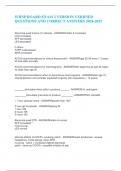WHNP BOARD EXAM 2 VERSION VERIFIED
QUESTIONS AND CORRECT ANSWERS 2024-2025
Abnormal quad trisomy 21 (downs) - ANSWERInhibin A increased
hCG increased
AFP decreased
uE3 decreased
if others
PAPP-A decreased
INHA increased
ACOG recommendations for clinical breast exam - ANSWERage 25-39 every 1-3 years
40 and older annually
ACOG recommendations for mammograms - ANSWERoffer beginning at age 40, begin
no older than age 50
ACOG recommendations when to discontinue mammograms - ANSWERafter age 75,
shared decision and consider expected longevity (life expectancy > 10 years)
stimulates theca cells to produce - ANSWERLH, androgens
stimulates granulosa to produce - ANSWERFSH, estradiol
+ 1 hour glucose result - ANSWERgreater than 140!
3 hour gtt thresholds - ANSWERfasting 95
1 hour 180
2 hours 155
3 hours 140
Abnormal quad NTD - ANSWERInhibin A normal
AFP Increased **
hCG normal
uE3 normal
adverse effects of COCPs, nuvaring, patch - ANSWERbreast tenderness, nausea,
headaches, mood swings, acne, BTB
nuvaring - same + increased vaginal discharge
patch - same as COCPs + possible irritation at site
,adverse effects of DMPA - ANSWERmenstrual bleeding pattern changes, unscheduled
vaginal bleeding, amenorrhea, mood swings, HA, acne, weight gain
adverse effects of POPs - ANSWERunscheduled menstrual bleeding, acne, mood
swings, HA, breast tenderness
AFI levels - ANSWER>24cm poly
10-24 normal
5.1 - 9.9 low normal
<5 oligo
age range of pubarche? female - ANSWER8-13
<8 or >13 referral to pediatric endo
Age range of tanner 2 onset for males - ANSWER9-14
age too early for
thelarche
pubarche - ANSWERthelarche 7
pubarche 8
ages and 2 vs 3 gardasil vaccines - ANSWERapproved for men and women aged 9-45
Before age 15 - 2 injections (0 and 6 months)
After age 15 - 3 injections (O, 2, and 6 months)
alcohol and metronidazole or tinidazole - ANSWERabstience of alcohol 24 hours after
completion for metronidazole, 72 hours for tinidazole
alternative to estrogen for HT for vasomotor symptoms - ANSWERProvera
SSRIs
Gabapentin
Alpha blockers - clonidine
Amenorrhea r/t hyperprolactinemia - ANSWERBreastfeeding, breast stimulation, liver or
kidney failure, ectopic production (dermoid cyst, cancer), meds: OCs, antipsychotics,
antidepressants, anti HTN, opiates
>100 - needs head MRI, empty sella syndrome, pituitary adenoma
amniocentesis - ANSWER*15-18 weeks*
Genetic and biochemical diagnosis, determine fetal lung maturity, assessment for fetal
disease
Risks fetal loss (0.5-1%), amnionitis (0.1%), ROM, infection, abruption, possible fetal
injury
Androgen insensitivity syndrome
Genetics
,Physical characteristics
serum testosterone? - ANSWER*typically present with primary amenorrhea*
Genetics 46 XY (male) - but they are unresponsive to androgens so they appear female
"female" from birth
absense of uterus and ovaries
vagina ends in blind pouch
fully developed breasts
*SCANT OR ABSENT PUBIC AND AXILLARY HAIR*
testes present in abdomen or inguinal canal
infertile, high risk for osteoporosis
"testicular feminization"
testosterone - same range as those found in males of same age
angle closure glaucoma - ANSWERsudden increase in intraocular pressure
Sx - unilateral, acutely red, painful eye with vision changes including halos around
lights, eye ball firm
Tx - immediate referral to ophthalmology
ASCCP guidelines when to pap - ANSWER21-29 years: every 3 years
30-65 years: Cotesting every 5, or pap alone every 3
65: stop if adequate negative cytology results and not at high risk for cervical cancer
CIN 2 or CIN 3: needs testing at least 20 years after abnormality found
Total hyst: stop, unless surgery done for treatment of cervical cancer
Hyst with cervix: normal guidelines
At risk ethnic groups for alpha thal minor - ANSWERAsian, African (AAA)
at risk ethnic groups for beta thal minor - ANSWERAfrican, Mediterranean, Middle
Eastern (BAMME)
Average length of follicular phase - ANSWER10-17 days
Bartholin glands should be
palpable?
tender? - ANSWERnonpalpable and nontender
BCC
Common?
Where and what?
Metastatic? - ANSWERMore common than SCC
On sun exposed areas
Arises de novo
Papule, pearly or waxy appearance with distinct borders
Metastatic risk low, can cause significant tissue destruction
Best abx for MRSA skin infection - ANSWERTMP/SMX - bactrim
, Best abx for MSSA skin infection - ANSWERDicloxacillin or cephalexin
Best indicator for asthma flare - ANSWERFEV
Bimanual exam of adenomyosis - ANSWERUterus slightly enlarged and globular;
remember, like endo only diagnosed with histology
Bimanual exam of endometriosis - ANSWERRV uterus with nodules
BPP scoring interventions - ANSWER<4 deliver
6 - depends, repeat in 24 hours
>8 - reassuring
CAGE questionnaire - ANSWERprovides very accurate information related to alcohol
abuse, 2 or greater response = + screen
Cut down on drinking
Annoyed you by criticizing your drinking
Guilty about your drinking
Eye opener - drink first thing in the morning or to get rid of hangover
calcium dosage - ANSWER>1200 mg/d
cancer reduction with combined contraceptive - ANSWERovarian cancer decrease
endometrial cancer decrease
colorectal cancer decrease
breast cancer slight increases risk
>5 years, increased risk of cervical cancer
Cardiac exam in MVP - ANSWERpresence of a Grade I-III/IV mid to late systolic
crescendo murmur with honking quality during peak pressure, which is the middle of
systole
Normal PMI
changes to the gums in pregnancy - ANSWERnormal physiologic - hyperemia of gums
and nasal passages
Chronic disease anemia in pregnancy
RBC morphology
transferrin/TIBC
Ferritin - ANSWERMicrocytic, hypochromic
Normal or decreased transferring/TIBC
Normal or increased ferritin
classic clinical findings in trick - ANSWERyellow-green, frothy discharge
cervical petechial hemorrhages (strawberry cervix)




